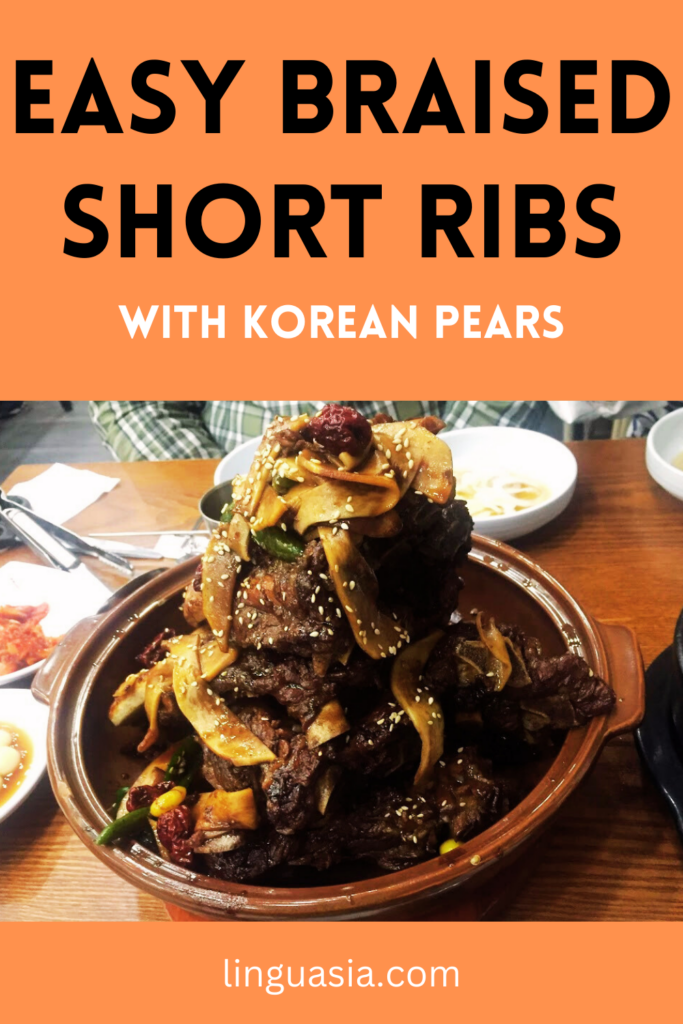
CRISP and JUICY sweetness! You might be surprised how delicious Korean pears can be.
They’re super filling, and actually help curb your appetite. So, they won’t leave you pear-shaped.
Korean pears or bae aren’t the most affordable fruit out there, but are totally worth trying.
Check out how Koreans enjoy pears, along with some awesome recipes and things you might find interesting!
Key Takeaways
- Korean pears are golden grapefruit-sized orbs, called “bae” in Korean.
- Autumn is the Korean pear harvest season. It coincides with the holiday Chuseok, so they’re often present at family gatherings.
- Korean pears are perfect for bulgogi or galbijjim marinade.
1. Peel Korean pears and eat them raw
Seems like a no-brainer, but the best and easiest way to enjoy a Korean pear is eating one straight up!
(Koreans have fruit after every meal, seriously!
No need to bake or cook it into a dessert, because these golden balls of deliriousness are naturally sweet.
Prepare a Korean pear like this:
- Cut the pear in half
- Slice the pear halves into halves
- Cut down diagonally to remove the core (like Apples, the seeds aren’t for eating)
- Peel the outer skin off the slices
- Plate the pear without the core and peels
- Enjoy this healthy, natural dessert!
2. Use them in a mouth-watering Bulgogi marinade
It’s kind of a secret, but not for Koreans.
Every Korean mom uses pears in bulgogi marinade, as they add sweetness while tenderizing the meat with protease. It’s like killing two birds with one tasty stone.
Here’s a bulgogi recipe:
- Slice beef as thinly as you can, then set aside in a large bowl.
- In a blender or food processor, blend onion chunks, garlic, pear, spring onion pieces, brown sugar, pepper, soy sauce and toasted sesame oil until smooth.
- Pour marinade over beef, add onions, then mix evenly. Cover with cling film and marinate for at least 30 minutes in the fridge (the longer the better).
- Heat canola oil in a skillet over high heat.
- Add enough marinated beef and onions as to not crowd the pan, sear until browned, then sprinkle with spring onions and sesame seeds.
- Serve with rice and side dishes!
Insider Tip!
If you can’t get fresh Korean pears for your marinade, use pear juice or puree instead. It gives basically the same effect.
3. Add succulent Korean pear to Galbijjim marinade
OMG, I LOVE galbijjim!
I haven’t met a single Korean person who doesn’t like it.
Just like with bulgogi, adding Korean pears does the trick.
I’ll share a quick and easy recipe:
- Soak beef short ribs in cold water for 1 hour, then drain.
- Bring water to a boil and blanch drained short ribs for 5 minutes.
- Dice large carrot, onion and white radish.
- Slice shiitake mushrooms into 1-inch-thick pieces, and chop garlic and ginger. Peel and grate Korean pear. Cut green onion lengthwise and cut them into a big bite-size pieces (1 inch).
- Combine all ingredients to make braising sauce.
- Pour the sauce over short beef ribs and bring to a boil. Skim off when boiling.
- Add 1 cup of water to beef short rib pot and put the lid on. Cook on medium heat for 50 minutes to 1 hour until beef short ribs are tender.
- Add white radish, carrot, onion and shiitake mushroom and cook them on low heat for about 15 minutes until they’re fully done.
- Turn off heat. Plate Galbi jjim in a big bowl.
- Enjoy the feast!

4. Have Yukhoe with Korean pear slices
Yukhoe literally means “meat sashimi”. It’s a Korean delicacy that you can find at any wedding buffet in the country.
Yukhoe is a super fresh raw beef dish seasoned with garlic, soy sauce, sesame oil, sugar (or honey), black pepper, toasted sesame seeds and more.
Korean pears pair perfectly.
You must enjoy this savory dish with thin strips of Korean pears! It’s not yukhoe without them.
5. Make Kimchi with Korean pears
Kimchi will have a more refreshing/cool taste when Korean pears are added to the seasoning/spices.
Korean pears are especially wonderful in “water kimchi (mool kimchi or dongchimi)”, which aids digestion.
Eating a baked/steamed sweet potato (goguma) with cold dongchimi in winter is just heavenly. It will complete the full Korean experience.

6. Eat Naengmyeon with Korean pear slices
Naengmyeon is THE summer food for Koreans, and literally means “cold noodles”.
It originates from North Korea, and comes in various forms, but the most common categorization would be: Mool naengmyeon in icy-cold broth and spicy Bibim naengmyeon.
Proper naengmyeon should always be garnished with Korean pears.
They also should be used in the broth for that slightly-sweet cold feeling. The last King of Joseon, Gojong, used to love naengmyeon, and his court lady said they made water kimchi full of pears for his broth.
7. Try Baesook (or Baesuk) when feeling under the weather
Baesook (or baesuk) is a steamed pear in honey. It’s the perfect dessert that works as a traditional cold medicine in South Korea.
You can either:
- Steam the whole pear with dates, ginger and honey inside the pear, or
- Boil the pear punch with peppercorns and other ingredients to make a nice winter party drink. It’s kind of like mulled wine.
8. Drink Korean pear juice
Haitai Crushed Pear Juice has been an institution in Korea since 1996.
It’s popular as a hangover cure, and as a substitute for pear juice when making marinades for Korean meat dishes like bulgogi, galbijjim, etc. It’s a lot cheaper than buying a fresh Korean pear.
9. Try Korean pear freezie (TankBoy by Haitai)
TankBoy was launched in 1997 as a freezie (jjujjuba) by Haitai. It’s great for warding off the heat in summer.
TankBoy tastes pretty good, and contains 12% pears and is 95 kcal.

What is a Korean pear?
Korean pears are golden grapefruit-sized orbs of flavor. Koreans have cultivated them over the years to be extra big and juicy. Hwangkeum is a cultivar that’s especially famous for being delicious. Korean pears are a local specialty of Naju, Jeollanam-do.
Korean pear tree

Pyrus pyrifolia is a species of tree native to East Asia that produces some tasty pears.
Korean pear season
Autumn is the Korean pear harvest season. It coincides with the holiday Chuseok, so they’re often present at family gatherings.
How many calories do Korean pears have?
176 kJ (42 kcal) per 100 g (3.5 oz)
How do I eat Korean pears?
You can simply wash them, and slice them into wedges while removing the core. You may peel the fruit first or not, it’s up to you!
Can cats and dogs eat Korean pears?
Yes! But serve in moderation. Pear seeds contain trace amounts of cyanide and should be removed before feeding your pet.










